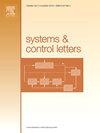存在时滞的静态映射无偏极值求的构造方法
IF 2.5
3区 计算机科学
Q3 AUTOMATION & CONTROL SYSTEMS
引用次数: 0
摘要
本文研究了存在时变测量延迟的n维不确定二次静态映射的无偏极值搜索算法。本文首次对无偏ES进行了定量分析。我们考虑具有较大的已知常数部分和较小的时变不确定性的时滞。当测量值与时间戳一起通过通信网络传输到ES控制器时,可能会出现这种延迟。对于定量界限,我们假设黑森在已知范围内是不确定的。通过应用无延迟变换,建立了依赖于调谐参数的简单标量不等式的明确定量条件,保证了ES系统的指数无偏收敛。并给出了经典ES的相应结果。对于全局二次映射,我们的结果是半全局的,而对于局部二次静态映射,我们给出了收敛区域的界。对于任何已知的大延迟和足够小的延迟不确定性,都可以找到合适的ES参数。文献中的两个数值算例说明了所提方法的有效性。本文章由计算机程序翻译,如有差异,请以英文原文为准。
Constructive method for unbiased extremum seeking of static maps in the presence of delays
In this paper, we study the unbiased extremum seeking (ES) algorithm for n-dimensional uncertain quadratic static maps in the presence of time-varying measurement delays. For the first time, we present a quantitative analysis of the unbiased ES. We consider delays with a large known constant part and a small time-varying uncertainty. Such delays may arise when measurements together with a time stamp are transmitted to ES controller via communication network. For the quantitative bounds, we assume that the Hessian is uncertain from a known range. By applying a delay-free transformation, explicit quantitative conditions in terms of simple scalar inequalities depending on the tuning parameters are established which ensure the exponential unbiased convergence of the ES system. Moreover, the corresponding results for the classical ES are presented. For globally quadratic maps, our results are semi-global, whereas for locally quadratic static maps, we provide a bound for the region of convergence. Appropriate ES parameters can be found for any large known delay and small enough delay uncertainty. Two numerical examples from the literature illustrate the efficiency of the proposed method.
求助全文
通过发布文献求助,成功后即可免费获取论文全文。
去求助
来源期刊

Systems & Control Letters
工程技术-运筹学与管理科学
CiteScore
4.60
自引率
3.80%
发文量
144
审稿时长
6 months
期刊介绍:
Founded in 1981 by two of the pre-eminent control theorists, Roger Brockett and Jan Willems, Systems & Control Letters is one of the leading journals in the field of control theory. The aim of the journal is to allow dissemination of relatively concise but highly original contributions whose high initial quality enables a relatively rapid review process. All aspects of the fields of systems and control are covered, especially mathematically-oriented and theoretical papers that have a clear relevance to engineering, physical and biological sciences, and even economics. Application-oriented papers with sophisticated and rigorous mathematical elements are also welcome.
 求助内容:
求助内容: 应助结果提醒方式:
应助结果提醒方式:


